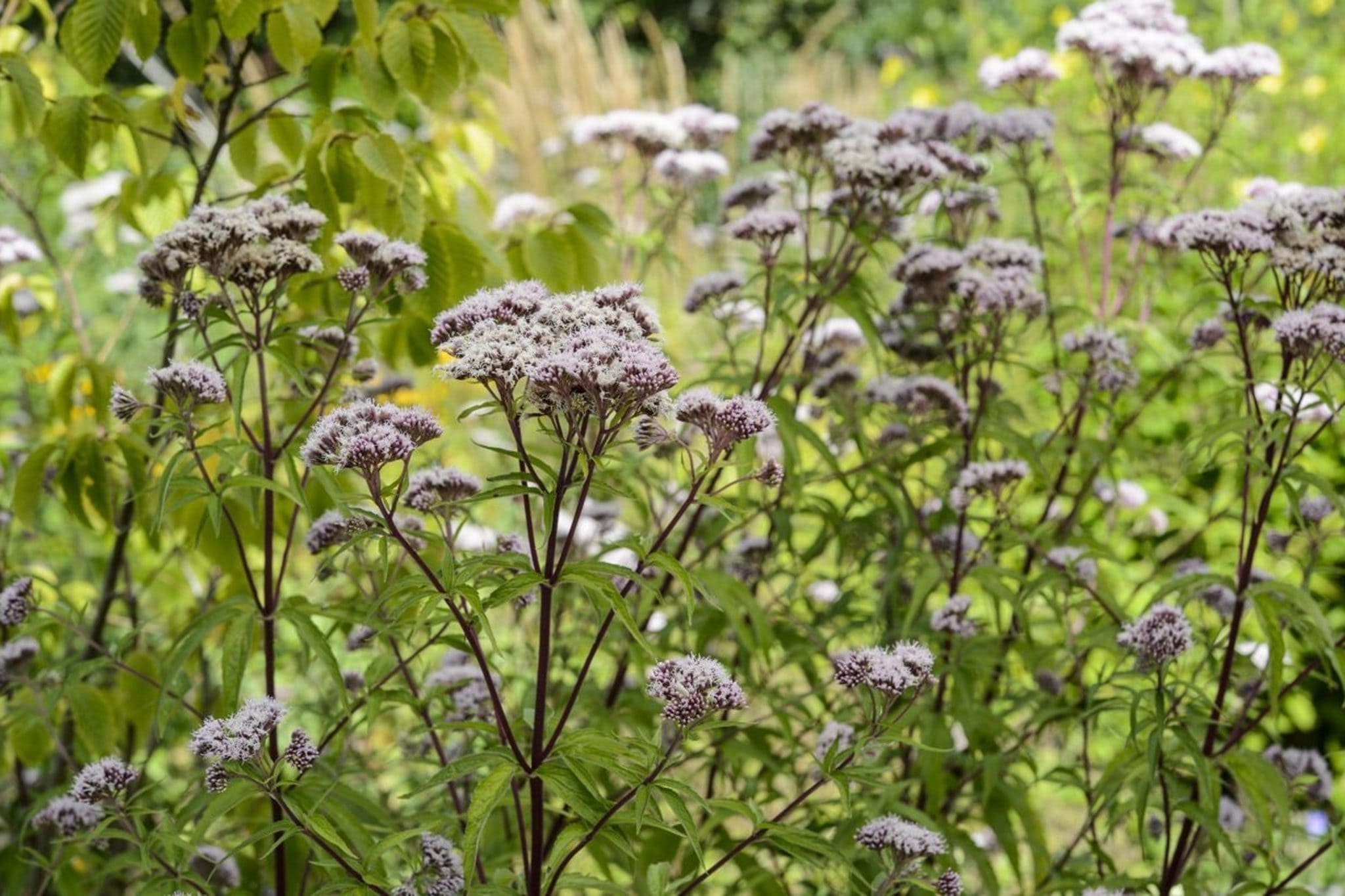
Eupatorium is a fascinating genus of flowering plants that belong to the Asteraceae family. Known for their beautiful blooms and medicinal properties, these plants have captured the interest of botanists and gardeners alike. Eupatorium species are commonly found in North America, Asia, and Europe, thriving in a variety of habitats from wetlands to woodlands. These plants are not just pretty faces; they play a crucial role in ecosystems by attracting pollinators like bees and butterflies. Whether you're a gardening enthusiast or a nature lover, learning about Eupatorium can deepen your appreciation for the natural world. Let's dive into 38 intriguing facts about this remarkable genus!
What is Eupatorium?
Eupatorium, commonly known as Joe-Pye weed, is a genus of flowering plants in the family Asteraceae. These plants are native to North America, Europe, and Asia. They are known for their tall stature and clusters of small, tubular flowers. Let's dive into some fascinating facts about Eupatorium.
Historical Significance
Eupatorium has a rich history and has been used for various purposes over the centuries.
- Named After a King: The genus name "Eupatorium" is derived from Mithridates Eupator, a king of Pontus who was known for his knowledge of herbal medicine.
- Native American Use: Native Americans used Eupatorium for medicinal purposes, particularly to treat fevers and respiratory issues.
- Colonial Medicine: Early American colonists adopted the use of Eupatorium from Native Americans, using it to treat typhus and other fevers.
- Symbol of Healing: In some cultures, Eupatorium is considered a symbol of healing and protection due to its medicinal properties.
Botanical Characteristics
Eupatorium plants have unique features that make them stand out in gardens and wild landscapes.
- Tall Growth: These plants can grow up to 7 feet tall, making them a striking addition to any garden.
- Flower Clusters: Eupatorium produces large clusters of small, tubular flowers that can be white, pink, or purple.
- Leaf Arrangement: The leaves are typically arranged in whorls of three to four around the stem.
- Late Bloomers: These plants usually bloom in late summer to early fall, providing color when many other plants have finished flowering.
- Attracts Pollinators: Eupatorium is known to attract a variety of pollinators, including bees, butterflies, and moths.
Ecological Importance
Eupatorium plays a significant role in its ecosystem, benefiting both wildlife and the environment.
- Habitat for Insects: The dense foliage provides shelter for various insects and small animals.
- Erosion Control: The extensive root system helps prevent soil erosion, particularly along riverbanks and in wetlands.
- Water Purification: Eupatorium can help filter and purify water in wetland areas, improving water quality.
- Biodiversity Support: By attracting pollinators, Eupatorium supports biodiversity and the health of surrounding plant communities.
Medicinal Uses
Eupatorium has been used in traditional medicine for centuries, and modern research continues to explore its potential benefits.
- Fever Treatment: Historically used to treat fevers, Eupatorium is sometimes called "feverweed."
- Respiratory Health: It has been used to alleviate symptoms of colds, coughs, and bronchitis.
- Anti-inflammatory Properties: Some studies suggest that Eupatorium may have anti-inflammatory effects.
- Digestive Aid: It has been used to treat digestive issues, including constipation and indigestion.
- Pain Relief: Eupatorium has been used as a natural remedy for pain relief, particularly for headaches and muscle aches.
Cultivation and Care
Growing Eupatorium in your garden can be rewarding, but it requires some specific care.
- Soil Preference: Eupatorium prefers moist, well-drained soil but can tolerate a range of soil types.
- Sunlight Needs: These plants thrive in full sun to partial shade.
- Watering Requirements: Regular watering is essential, especially during dry periods.
- Pruning Tips: Pruning in early spring can help maintain the plant's shape and encourage healthy growth.
- Pest Resistance: Eupatorium is relatively resistant to pests and diseases, making it a low-maintenance choice for gardeners.
Varieties of Eupatorium
There are several species and varieties of Eupatorium, each with its unique characteristics.
- Eupatorium purpureum: Also known as sweet Joe-Pye weed, this species is known for its fragrant, pinkish-purple flowers.
- Eupatorium maculatum: Commonly called spotted Joe-Pye weed, it features purple-spotted stems and mauve flowers.
- Eupatorium perfoliatum: Known as boneset, this species has white flowers and is often used in herbal medicine.
- Eupatorium cannabinum: Also called hemp agrimony, it is native to Europe and Asia and has pinkish flowers.
- Eupatorium rugosum: Known as white snakeroot, this species has white flowers and is toxic to livestock.
Interesting Facts
Eupatorium has some intriguing qualities and associations that make it even more fascinating.
- Named by Carl Linnaeus: The famous botanist Carl Linnaeus named the genus Eupatorium in the 18th century.
- Butterfly Magnet: Eupatorium is particularly attractive to monarch butterflies, which rely on it for nectar during migration.
- Mythical Associations: In some folklore, Eupatorium is associated with protection against evil spirits.
- Used in Dyeing: Some species of Eupatorium have been used to produce natural dyes.
- Toxicity: While beneficial in many ways, some species of Eupatorium, like white snakeroot, are toxic to livestock and humans if ingested.
Conservation Status
The conservation status of Eupatorium varies depending on the species and region.
- Common in the Wild: Many species of Eupatorium are common and not considered at risk.
- Habitat Loss: Some species are threatened by habitat loss due to development and agriculture.
- Conservation Efforts: Efforts are being made to protect and restore habitats where Eupatorium species are at risk.
- Cultivation for Conservation: Growing Eupatorium in gardens can help support local ecosystems and conservation efforts.
Fun Facts
Let's end with some fun and quirky facts about Eupatorium.
- Named After a Mythical King: The genus name "Eupatorium" honors Mithridates Eupator, a king who was famous for his knowledge of poisons and antidotes.
Final Thoughts on Eupatorium
Eupatorium, often called Joe-Pye weed, is more than just a pretty face in the garden. This plant, with its clusters of pink or purple flowers, has a rich history in traditional medicine. Native Americans used it to treat fevers, hence the nickname "feverweed." Beyond its medicinal uses, Eupatorium attracts pollinators like butterflies and bees, making it a valuable addition to any garden. It thrives in moist, well-drained soil and can grow up to seven feet tall. While it’s generally low-maintenance, watch out for powdery mildew. Knowing these facts can help you appreciate this plant even more. Whether you're a gardener, a nature enthusiast, or just curious, Eupatorium offers something for everyone. So next time you see this plant, remember its history, benefits, and beauty. Happy gardening!
Was this page helpful?
Our commitment to delivering trustworthy and engaging content is at the heart of what we do. Each fact on our site is contributed by real users like you, bringing a wealth of diverse insights and information. To ensure the highest standards of accuracy and reliability, our dedicated editors meticulously review each submission. This process guarantees that the facts we share are not only fascinating but also credible. Trust in our commitment to quality and authenticity as you explore and learn with us.


